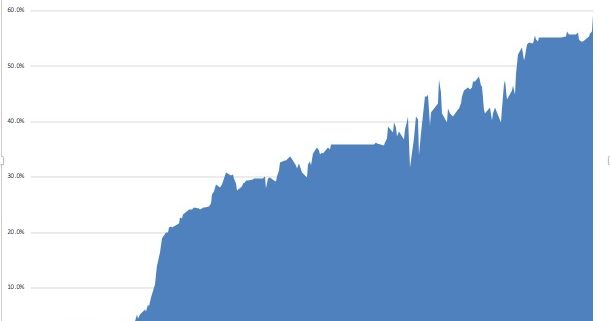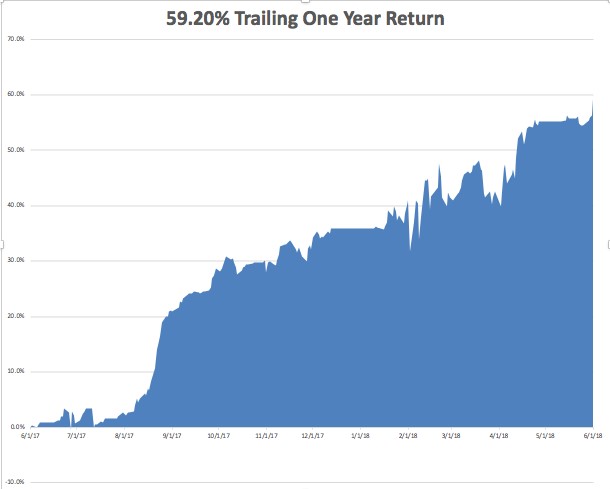Global Market Comments
June 4, 2018
Fiat Lux
Featured Trade:
(WEDNESDAY, JUNE 13, 2018, PHILADELPHIA, PA, GLOBAL STRATEGY LUNCHEON)
(THE MARKET OUTLOOK FOR THE WEEK AHEAD, or NEW ALL-TIME HIGHS AND NEW ALL-TIME HIGHS),
(AAPL), (FB), (AMZN), (MSFT), (TLT)
Tag Archive for: (TLT)
We knew the May Nonfarm Payroll Report was coming in hot when the president leaked the numbers ahead of time. He tweeted that he "Was looking forward to" the numbers hours before the official release.
Last month, when the report was weak, we heard nary a word from Twitter. Just add that to the ever-growing list of unpredictables we traders have to deal with on a daily basis.
As for myself, I was looking for robust numbers last Tuesday when I piled on an aggressive, highly leveraged short position in the bond market, right at the four months highs. When bonds collapsed my reward was a 62.50% profit in only three trading days.
In the blink of an eye, we have made back half of the drop in interest rates prompted by the Italian political crisis. Ten-year U.S. Treasury yields plunged from 3.12% all the way down to 2.75% and are now back up to 2.92%. Bonds have almost fallen three points in three days.
This trade instructs you on the merits of going outright long options instead of more conservative spreads when you expect a very sharp, rapid move in the immediate term.
The result was to take the performance of the Mad Hedge Trade Alert Service to yet another all-time high. Those who signed up at any time in the past 12 months have to be extremely happy.
After one trading day, my June return is +2.94%, my year-to-date return stands at a robust 23.31%, my trailing one-year return has risen to 59.20%, and my eight-year profit sits at a 299.78% apex.
The payroll report suggests that the nine-year economic expansion will easily growth to 10. Never mind that we are putting it all on an American Express card and that our kids are going to have to pick up the tab. For now, it's happy days.
That means my 2018 year-end forecast is alive and well for a (SPY) of 3,000. If earnings continue to grow at a 25% annual rate and you assume a modest 17.5 X, getting there is a chip shot. Next year is another story, when year-on-year growth rates fall to zero.
The jobs report came in at 223,000 versus the three-month average of 175,000, and the Headline Unemployment Rate dropped to 3.8%, a new decade low. Average Hourly Earnings rose to an inflationary 0.3%.
Retail gained 31,0000 jobs, Health Care 29,000, and Construction 25,000. Only Temporary Workers lost 7,800.
The broader U-6 "discouraged worker" unemployment rate fell to 7.6%, a 17-year low.
The major hallmark of the week was an upside breakout of technology. Microsoft (MSFT), Amazon (AMZN), Apple (AAPL), and Facebook (FB) all hit historic highs.
I don't know why tech is breaking out here. Maybe the market is discounting another round of blockbuster quarterly earnings that starts in two months. Possibly the tech growth rate is accelerating at the granular level.
Perhaps there is nothing else to buy. But for whatever reason, tech is going up and I want in. Tech is the secular growth story of our generation and will remain so for the foreseeable future.
The smartest that I have done this year is to start my Mad Hedge Technology Letter in February as it added 60 hours of research into tech companies into our research mix. As a result, the readers are swimming in profits.
This coming week is nearly clueless in terms of hard data releases.
On Monday, June 4, at 10:00 AM, we get May Factory Orders.
On Tuesday, June 5, May PMI Services is announced.
On Wednesday, June 6, at 7:00 AM, the MBA Mortgage Applications come out.
Thursday, June 7, leads with the Weekly Jobless Claims at 8:30 AM EST, which saw a fall of 11,000 last week from a 43-year low.
On Friday, June 8, at 8:30 AM EST, we get the Baker Hughes Rig Count at 1:00 PM EST, which rose by only 1 last week.
As for me, I will be glued to my TV watching the local Golden State Warriors trounce the Cleveland Cavaliers. That's providing they can overcome LeBron James, who seems to be a force of nature.
Good Luck and Good Trading.
New Highs!
Those planning a European vacation this summer just received a big gift from the people of Italy.
Since April, the Euro (FXE) has fallen by 10%. That $1,000 Florence hotel suite now costs only $900. Mille grazie!
You can blame the political instability on the Home of Caesar, which has not had a functioning government since March. The big fear is that the extreme left would form a coalition government with the extreme right that could lead to its departure from the European Community and the Euro. Think of it as Bernie Sanders joining Donald Trump!
In fact, Italy has had 61 different governments since WWII. It changes administrations like I change luxury cars, about once a year. Welcome to European debt crisis part 27.
I can't remember the last time markets cared about what happened in Europe. It was probably the first Greek debt crisis in 2011. This month, 10-year Italian bond yields have rocketed from 1% to 3%. But they care today, big time.
Given the reaction of the global financial markets, you could have been forgiven for thinking that the world had just ended.
U.S. Treasury Bond yields (TLT) saw their biggest plunge in years, off 15 basis points to 2.75%. The Dow Average ($INDU) collapsed by $500 to $24,250, with interest sensitive banks such J.P. Morgan Chase (JPM) and Bank of America (BAC) delivering the worst performance of the day.
Even oil prices collapsed for an entirely separate set of reasons - so far, the best performing commodity of 2018. The price of Texas Tea pared 10% in a week.
Saudi Arabia looks like it is about to abandon the wildly successful OPEC production quotas that have been boosting oil prices for the past year, and there are concerns that Iran will withdraw from the nuclear non-proliferation treaty. The geopolitical premium is back with a vengeance.
So, if the Italian developments are a canard why are we REALLY going down?
You're not going to like the answer.
It turns out that rising inflation, interest rates, oil and commodity prices, the U.S. dollar, U.S. national debt, budget deficits, and stagnant wage growth are a TERRIBLE backdrop for risk in general and stocks specifically. And this is all happening with the major indexes at the top end of recent ranges.
In other words, it was an accident waiting to happen.
Traders are extremely nervous, global uncertainty is high, the seasonals are awful, and Washington is s ticking time bomb. If you were wondering why I was issuing so few Trade Alerts in May these are the reasons.
This all confirms my expectation that markets will remain in increasingly narrow trading ranges for the next six months until the mid-term congressional elections.
Which is creating opportunities.
If you hated bonds at a 3.12% yield from two weeks ago, you absolutely have to despise them at 2.75% today. That's why I added outright bond put options today to my model trading portfolio.
Stocks are still wildly overvalued for the short term, so I'll keep my short position there. As for oil (USO), gold (GLD), and the currencies, I don't want to touch them here.
So watch for those coming Trade Alerts. I'm not dead yet, just resting.
Waiting for My Shot
Ignore the lessons of history, and the cost to your portfolio will be great. Especially if you are a bond trader!
Meet deflation, up-front and ugly.
If you looked at a chart for data from the United States, consumer prices are showing a feeble 2.5% YOY price gain. This is slightly above the Federal Reserve's own 2% annual inflation target, with most of the recent gains coming from rising oil prices.
And here's the rub. Wage growth, which accounts for 70% of the inflation calculation, has been practically nil. So, don't expect inflation to rise much from here, despite an unemployment rate at a 17-year low.
We are not just having a deflationary year or decade. We may be having a deflationary century.
If so, it will not be the first one.
The 19th century saw continuously falling prices as well. Read the financial history of the United States, and it is beset with continuous stock market crashes, economic crisis, and liquidity shortages.
The union movement sprung largely from the need to put a break on falling wages created by perennial labor oversupply and sub living wages.
Enjoy riding the New York subway? Workers paid 10 cents an hour built it 120 years ago. It couldn't be constructed today, as other more modern cities have discovered. The cost would be wildly prohibitive.
The causes of 19th century price collapses were easy to discern. A technology boom sparked an industrial revolution that reduced the labor content of end products by 10 to hundredfold.
Instead of employing 100 women for a day to make 100 spools of thread, a single man operating a machine could do the job in an hour.
The dramatic productivity gains swept through then developing economies like a hurricane. The jump from steam to electric power during the last quarter of the century took manufacturing gains a quantum leap forward.
If any of this sounds familiar, it is because we are now seeing a repeat of the exact same impact of accelerating technology. Machines and software are replacing human workers faster than their ability to retrain for new professions.
This is why there has been no net gain in middle class wages for the past 30 years. It is the cause of the structural high U-6 "discouraged workers" employment rate, as well as the millions of Millennials still living in parents' basements.
To the above add the huge advances now being made in healthcare, biotechnology, genetic engineering, DNA-based computing, and big data solutions to problems.
If all the major diseases in the world were wiped out - a probability within 10 years - how many health care jobs would that destroy?
Probably tens of millions.
So the deflation that we have been suffering in recent years isn't likely to end any time soon. If fact, it is just getting started.
Why am I interested in this issue? Of course, I always enjoy analyzing and predicting the far future, using the unfolding of the last half-century as my guide. Then I have to live long enough to see if I'm right.
I did nail the rise of eight-track tapes over six-track ones, the victory of VHS over Betamax, the ascendance of Microsoft operating systems over OS2, and then the conquest of Apple over Microsoft. So, I have a pretty good track record on this front.
For bond traders especially, there are far-reaching consequences of a deflationary century. It means that there will be no bond market crash, as many are predicting, just a slow grind up in long-term interest rates instead.
Amazingly, the top in rates in the coming cycle may only reach the bottom of past cycles, around 3% for 10-year Treasury bonds (TLT), (TBT).
The soonest that we could possibly see real wage rises will be when a generational demographic labor shortage kicks in during the 2020s. That could be a decade off.
I say this not as a casual observer, buy as a trader who is constantly active in an entire range of debt instruments.
So, the bottom line here is that there is additional room for bond prices to fall and yields to rise is pretty limited. But not by that much, given historical comparisons. Think of singles, and not home runs.
It really will just be a trade. Thought you'd like to know.
Yup, This Will Be a Real Job Killer
Global Market Comments
May 25, 2018
Fiat Lux
Featured Trade:
(FRIDAY, AUGUST 3, 2018, AMSTERDAM, THE NETHERLANDS GLOBAL STRATEGY DINNER),
(MAY 23 BIWEEKLY STRATEGY WEBINAR Q&A),
(TLT), (SPY), (TSLA), (EEM), (USO), (NVDA),
(GILD), (GE), (PIN), (GLD), (XOM), (FCX), (VIX)
Below please find subscribers' Q&A for the Mad Hedge Fund Trader May 23 Global Strategy Webinar with my guest and co-host Bill Davis of the Mad Day Trader.
As usual, every asset class long and short was covered. You are certainly an inquisitive lot, and keep those questions coming!
Q: Would you short Tesla here?
A: Tesla (TSLA) is on the verge of making the big leap to mass production, so they're in somewhat of an in-between time from a profit point of view, and the burden of proof is on them. Elon Musk is notorious for squeezing shorts. I would not want to bet him.
Musk has been successfully squeezing shorts for 10 years now, from the time the stock was at $16.50 all the way up to $392. So, I would not short Tesla. Buy the car but don't play in the stock; it's really a venture capital play that happens to have a stock listing because so many people are willing to back his vision of a carbon-free economy.
Q: What is your takeaway on the China trade war situation?
A: The Chinese said "no," and that is positive for economic growth. Anything that enhances international trade is good for growth and good for the stock market; anything that damages international trade is bad for corporate earnings and bad for the stock market. So, the China win in the trade war is essentially positive, but I don't think we'll see that reflected in stock prices until the end of the year.
Q: What do you think about Gilead Sciences?
A: I don't really want to touch Gilead (GILD), or the entire sector, for that matter. We shouldn't be seeing such a poor performance at this point in the market. Health care has been dead for a long time, and you would have expected a rally based purely on fundamentals; they are delivering good earnings, it's just not reflected in the price action of the stocks. I think with no new money going into the market, there's nothing to push up other sectors; it's really become a "technology on and off" market. Health care doesn't fit anywhere in that world.
Q: Do you still like Nvidia?
A: I love Nvidia (NVDA). The chip sector still has another year to go. Nvidia has the high value-added product, and I'm looking for $300 dollars a share sometime this year/next year. The reason the stock hasn't really been moving is that it's over-owned; too many people know about the Nvidia story, which continues to go "gangbusters," so to speak. The chairman has also put out negative comments on short-term inventories, which have been a drag.
Q: Treasuries (TLT) are over 3%. Will they go over 3.5% by then end of this year?
A: I would say yes. Since that is only 50 basis points away from the current market, I would say it's a pretty good bet. So, if you get any good entry points you can do LEAPS going out to next year, betting that Treasuries will not only be below $116 by the end of the year, but they'll probably be below 110. And that would give you a very good high return LEAP with a yield of 50% in the next, say 8 months. By the way, if the Treasury yield rises to 4% that takes the (TLT) down to $98!
Q: Any chance General Electric will be acquired this year?
A: Absolutely not. General Electric (GE) worth far more if you break it up into individual pieces and sell them. Some parts are very profitable like jet engines and Baker Hughes, while other parts, like their medical insurance exposure, are awful.
Q: What do you see about the India ETF?
A: The one I follow is the PowerShares India Portfolio ETF (PIN) and we love it long term. Short term, they can take some pain with the rest of the emerging markets.
Q: What should I do with my January 2019 Gold calls?
A: I would sell them. It's not worth hanging on to here with too many other better things to do in stocks.
Q: Would you continue to hold ExxonMobile?
A: I would not. If you were lucky enough to get in at the bottom on ExxonMobile (XOM). I would be taking profits here. I'm not sure how long this energy rally will last, especially if the global economic slowdown continues.
Q: Is Freeport-McMoRan (FCX) a buy?
A: Yes, but only buy the dip in the recent range, so you don't get stopped out when the price goes against you. Commodities are the best performing asset class this year and that should continue.
Q: How high is oil (USO) headed?
A: I think we're probably peaking out short of $80 a barrel currently unless we get a major geopolitical event. Then it could go up to $100 very quickly and trigger a recession.
Q: Are you looking to buy the Volatility Index here?
A: Buy the next dip, but the trick with (VIX) is buying after it sits on a bottom for about five days. You also want to buy it when stocks (SPY) are at the top of a range, like yesterday.
Q: How long do you think the market will be range-bound for?
A: My bet is at least three months, and possibly four or five. We should start to anticipate the outcome of the midterm congressional elections in September/October; that's when you get your upside breakout.
Q: Is Gold (GLD) not worth buying since Bitcoin has taken over market share from Gold buyers?
A: Essentially, yes. That's probably why you're not getting these big spikes in Gold like you're used to. Instead, you're getting them in Bitcoin. Bitcoin is clearly stealing Gold's thunder. That's a major reason why we haven't been chasing Gold this year.
Q: After the emerging market sell-off, is it a good time to go in?
A: No, I think the emerging market (EEM) sell-off is being created by rising interest rates and a strong dollar. I don't see that ending anytime soon. In a year let's take another look in emerging markets. By then overnight Fed funds should be at 2.50% to 2.75%.
Global Market Comments
May 23, 2018
Fiat Lux
Featured Trade:
(MONDAY, JULY 16, 2018, PARIS, FRANCE, GLOBAL STRATEGY LUNCHEON),
(WHY I'M SELLING SHORT THE STOCK MARKET),
(SPY), (TLT),
(TESTING TESLA'S SELF-DRIVING TECHNOLOGY),
(TSLA)
All good things must come to an end, and I think the latest rally in stocks has just about run out of steam.
Up 12 out of 14 days, and the stock market is starting to reach a point of exhaustion. The S&P 500 (SPY) is now at the top end of a four-month trading range.
In addition, we are now well into a seasonally negative period for stocks, the six months when the total return on indexes is zero. The summer slowdown is upon us, and the declining trading volume is screaming at us loud and clear.
Please note that for the past months, stocks have been rising on small volume and falling on big volume. That is classic late cycle market action and is increasingly making me afraid of my own shadow.
We have just had an onslaught of surprise good news that took us up this high, thus giving us a fabulous short side entry point.
That would include a China trade war temporarily going on hold, the administration's free pass for Iran sanctions busting for the multinational Chinese telecom company ZTE, and Micron Technology's (MU) announcement of a $10 billion share buyback. Good news tends to happen in three's, and on the third one you sell.
So, a shot on the short side is reasonable here. However, doing ANY trade with the Volatility Index (VIX) down here at the $12 handle is a bit of a stretch. But I have only sent out one Trade Alert so far in May, and my traders are starving for fresh red meat.
I am not turning bearish, nor do I expect a recession to strike imminently. That will take place in late 2019 at the earliest. I'm just executing a short-term trade here to keep from being bored to death.
It is all just a matter of numbers. The American labor force is currently growing at 0.5% a year, while productivity is expanding by 1.5%. Add them together and that gives you 2% annual trend growth. Add in a 2% inflation rate and you get a 4% nominal GDP growth rate.
That growth rate means the Fed funds overnight interest rate should be 2.5%, a full 1% above the present 1.5%, so four more 25 basis point Fed rate hikes are a sure thing. It will get to 2.5% in a year.
Similarly, a 4% nominal growth rate historically brings you a 4% 10-year U.S. Treasury bond yield versus the current 3.07%, so we have another year to get to 4% as well.
That means our short strategy in the (TLT) is alive and well, we're just waiting for a better entry point. A 4% Treasury bond targets $98 on the downside in the (TLT), or down another $19 from today's close.
With a price earnings multiple 17X and an assumed earnings per share of $155, that puts the fair value for the S&P 500 of $2,720, or exactly where it is right now.
So the stock market isn't expensive, rich, or euphoric. Nor is it at bargain basement throwing the baby out with the bathwater cheap. It is dead in the middle.
And bull markets never end with fair valuation; they end with valuation upside blowouts. We dallied there at the end of January, but only for a few days. We may not see those high numbers again until the end of 2018.
And here's the bad news. Trading conditions could remain like this for another five months, until the November midterm congressional elections.
Just thought you'd like to know.
Global Market Comments
May 22, 2018
Fiat Lux
Featured Trade:
(DON'T MISS THE MAY 23 GLOBAL STRATEGY WEBINAR),
(CHINA'S BIG TRADE WIN),
(SPY), (TLT), (UUP), (USO), (GLD), (SOYB),
(HOW TO USE YOUR CELL PHONE ABROAD)
My phone started ringing on Sunday afternoon as soon as the futures markets opened in Asia. The U.S. had reached agreement with China on trade and the Dow futures were up 200 points.
Had the next leg of the bull market begun? ?Was it time to buy?
I asked what were the specifics of the deal. There weren't any. I asked about generalities. Those were absent as well.
All they knew was that the U.S. was suspending threatened tariff increases in exchange for a vague Chinese promise to buy more U.S. exports over the long term.
It was in effect a big Chinese win. The development allows the Middle Kingdom to do nothing but stall for time until the next U.S. administration comes to power regardless of which party wins. The Chinese think in terms of centuries, so waiting three more years for a better negotiating backdrop is no big deal.
It vindicates my own call on how the Chinese trade war would play out. After a lot of threats and saber rattling, the administration would achieve nothing, declare victory, and go home.
Traders should NOT be buying this pop in stock prices on pain of death. All that will happen is that stocks will trade back up to the top of the recent range, and then stall out once again as we slide back into slow summer trading. In fact, all we have accomplished is to revisit last week's high in stocks.
Stocks (SPY) weren't buying this trade agreement for two seconds, nor were bonds (TLT), foreign exchange (UUP), gold (GLD), or energy (USO). Not even the agricultural markets were believing it. Soybeans (SOYB), the commodity most affected by the China trade, were up a measly 2.45%. If markets really believed something substantial was afoot they would be limit up three days in a row. I've seen this happen.
It was obvious that little was accomplished when you saw the endless parade of administration officials praising the deals merits. My half century of trading experience has taught me when someone is working so hard to sell you a bridge, you look the other way.
And here is the problem. Beyond cutting-edge technology, there's nothing that China HAS to buy from the U.S. China's largest imports are in energy and foodstuffs, both globally traded commodities.
The oil and gas coming out of America looks pretty much like the Saudi Arabian and Russian kind. U.S. energy infrastructure is already groaning at the seams as it approaches 11 million barrels a day.
To double that from current levels just to fill the trade gap with China would require a multi-decade effort financed with trillions of dollars in private capital just to produce more oil with prices at a three-year high. In other words, it isn't going to happen.
The same is true with agriculture. I doubt there is a single farmer in the country willing to risk his own money to increase production on the back of the China deal. Rainfall is a much bigger concern.
In the end, stocks will eventually rise to new highs by the end of the year, just not right now. And they will do so on the back of the prodigious earnings growth of U.S. companies, which has been expanding at a breakneck pace for nearly a decade.
It is notable that the only major index that hit new highs today was the small cap Russell 2000 (IWM) where the constituent companies essentially do NO trade with China.
To believe otherwise would be giving the cock the credit for the sun rising, which happens every morning like clockwork.
It Worked Again!
Legal Disclaimer
There is a very high degree of risk involved in trading. Past results are not indicative of future returns. MadHedgeFundTrader.com and all individuals affiliated with this site assume no responsibilities for your trading and investment results. The indicators, strategies, columns, articles and all other features are for educational purposes only and should not be construed as investment advice. Information for futures trading observations are obtained from sources believed to be reliable, but we do not warrant its completeness or accuracy, or warrant any results from the use of the information. Your use of the trading observations is entirely at your own risk and it is your sole responsibility to evaluate the accuracy, completeness and usefulness of the information. You must assess the risk of any trade with your broker and make your own independent decisions regarding any securities mentioned herein. Affiliates of MadHedgeFundTrader.com may have a position or effect transactions in the securities described herein (or options thereon) and/or otherwise employ trading strategies that may be consistent or inconsistent with the provided strategies.






































